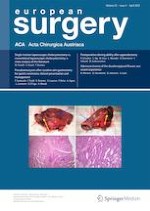13.02.2023 | original article
Pseudoaneurysms after curative-aim gastrectomy for gastric carcinoma: clinical presentation and management
Erschienen in: European Surgery | Ausgabe 2/2023
Einloggen, um Zugang zu erhaltenSummary
Background
Postoperative bleeding after gastrectomy is a rare but life-threatening complication. Most cases develop from the celiac trunk or hepatic artery branches in the early postoperative period, or as late bleeding even weeks after surgery. The main cause is believed to be arterial damage during lymphadenectomy. Arterial pseudoaneurysms are a risk factor for late abdominal bleeding after curative-aim gastrectomy. In this study, we describe the clinical management and treatment options of this condition.
Methods
We evaluated the incidence of pseudoaneurysms among a 10-year series of patients undergoing curative-aim gastrectomy. To establish the incidence of pseudoaneurysms and their impact on clinical practice, we reviewed the clinical follow-up data of all patients and the CT scans performed during follow-up. The CT scan review was aimed at identifying new-onset vascular abnormalities. A total of 156 patients were included.
Results
The overall incidence of postoperative pseudoaneurysms was 3.2%. A D2 or D2+ lymphadenectomy was performed in 131 cases. The incidence of postoperative bleeding due to ruptured pseudoaneurysm was 1.9%. Interventional radiology was the first treatment line for hemodynamically stable patients and had a 50% success rate. Radiological treatments were represented by embolization with coils and glue, or metallic stent placement.
Conclusion
The extent of lymphadenectomy and the neoadjuvant treatments did not seem to have an impact on the onset of pseudoaneurysms. Surgical site infections represent a significant risk factor for pseudoaneurysm rupture. Radiological treatment could be safely performed in hemodynamically stable patients and represented a feasible alternative to surgery.
Anzeige
